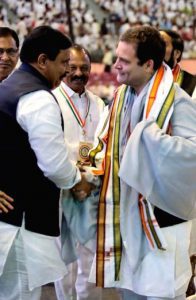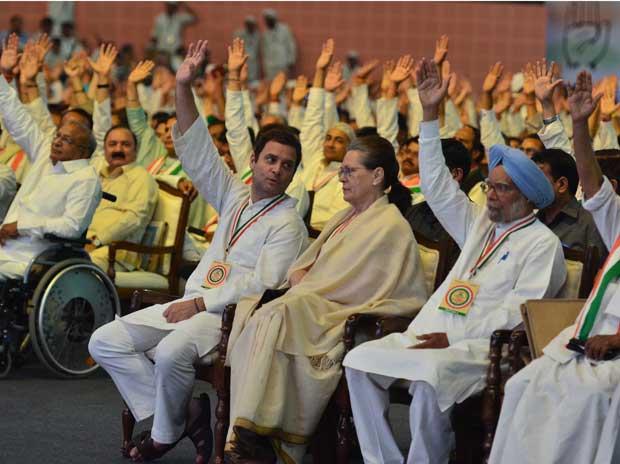Reading Time: 5 minutes
The Congress, trying to come out of one of the worst crisis it has faced in its 133-year-long history, used the 84th plenary in Delhi to set an agenda for the future. The new party President Rahul Gandhi made one of his most aggressive speeches yet with an unflinching attack on BJP’s record on economic management, social harmony, institutions, and corruption. He framed the confrontation with Narendra Modi-led party as a war between truth and lies, the Pandavas vs Kauravas. The Congress, he said, was like Pandavas who “lost everything but fought for truth” and finally won. Here’s a report, for Different Truths.
Each plenary session of the Congress has sent a message to the people. Perhaps, the most important one was when the Congress completed 100 years of its existence. The centenary plenum was held in Bombay in June 1985 where Rajiv Gandhi, who headed the Congress and was Prime Minister, made his famous “power broker” speech. The Bombay plenary was held when the Congress was at the peak, with Rajiv Gandhi having got highest ever—over 400 seats—in the Lok Sabha and ruled most of the states.
The plenum held in Delhi’s sprawling Indira Gandhi indoor stadium, to puts its seal of approval on Rahul Gandhi’s elevation as the Congress President, was at a time when the grand old party has been passing through most difficult time. Contrast Bombay Centenary session with Delhi plenary. The Congress is now at its worst, having got only 44 seats in Lok Sabha in the last general elections and rules only two major states—Punjab and Karnataka and two smaller state—Mizoram and Puducherry.
Rahul and his party have been slightly emboldened after putting a strong challenge in Gujarat to the ruling BJP, winning by-polls in Rajasthan and seeing the BJP suffer in Uttar Pradesh. The big challenge is ahead with coming elections in Karnataka in May and the year-end poll in Rajasthan, Madhya Pradesh, and Chhattisgarh. If the Congress retains Karnataka and wins the three northern states, the party may go to the general election with its head high.
At the core of the 84th plenary in Delhi was the rallying cry of preparing for the 2019 general elections. The Congress, trying to come out of one of the worst crisis it has faced in its 133-year-long history, used plenum to set an agenda for the future. The new party President Rahul Gandhi made one of his most aggressive speeches yet with an unflinching attack on BJP’s record on economic management, social harmony, institutions, and corruption.
He renewed the battle cry against the BJP on a stage symbolically of the old. He framed the confrontation with Narendra Modi-led party as a war between truth and lies, the Pandavas vs Kauravas. The Congress, he said, was like Pandavas who “lost everything but fought for truth” and finally won.
Rahul’s speech, Sonia Gandhi’s address and the political and economic resolutions adopted at the meet collectively illustrate the Congress agenda for 2019. The party’s main tactic will be “pragmatic” alliances. Recognising its own weaknesses, and need to prevent the fragmentation of anti-BJP votes, it has reiterated its openness to pacts—without claiming leadership. The party’s main campaign plank will be the economy and the promise of growth, jobs, and welfare. The idea is to capitalise on what the party thinks is the failure of the Modi government to bring “achhe din”. Its main constituency will be farmers and youth.
The plenum adopted a special resolution on agriculture and employment and poverty alleviation. It not only tried to address the agrarian crisis that is rapidly turning into the key electoral issue but virtually released a manifesto with promise for farmers. The eight-page resolution listed measures that the party would take for farmers, should it return to power at the Centre. The promise ranged from setting up Majdoor Welfare Aayog (labour welfare commission) with constitutional status, a special scholarship for farmers’ children, review of the methodology for determining minimum support prices, and setting up of special agricultural zones.
The special resolution on agriculture and employment and poverty alleviation as well as sections of economic resolution, sought to send out the message that, a party is so far seen as “left of the centre”, was presenting a more leftist outlook. The advocates of the trickle-down theory turned their focus to pro-poor and pro-farmers initiatives. Apart from the need to address the unemployment and agrarian crisis, some of the major challenges that the Congress identified in the economic policy are: providing high-quality education, health care and a social safety net for hundreds of millions of very poor. It also promised that there would be “large investments by the state in education, healthcare and social safety nets and an efficient public delivery system”.
With jobless being projected as a failure of the central government, it was one of the primary thrusts of the  Congress’ economic policy. It promised that a Congress-led government would involve the private sector in meeting the challenge. “Good productive job can be created in large numbers by India’s private sector driven by trade, manufacturing, construction, and exports.” The resolution assured that there will not be any “tax terrorism” and motivated litigation.
Congress’ economic policy. It promised that a Congress-led government would involve the private sector in meeting the challenge. “Good productive job can be created in large numbers by India’s private sector driven by trade, manufacturing, construction, and exports.” The resolution assured that there will not be any “tax terrorism” and motivated litigation.
Asserting that a return to power in 2019 is possible for the UPA, the economic resolution said “it shall focus its poverty alleviation policies on the bottom of 30 percent of the population” and promised it would be caste-neutral.
On the problems created by Aadhaar, the Congress said a large section of the public has been upset over the imposition of Aadhaar. It alleged the government has “distorted the concept and use of Aadhaar; instead of being an instrument of empowerment, it has been turned into an intrusive instrument to control and, in many cases, of exclusion of the very poor.”
In his concluding address, Rahul Gandhi did what few party leaders would have ever been bold enough to do. He clarified his view of Hinduism, going much beyond the usual line of “Hindutva is not Hinduism”. He differentiated between Hindu religion, he and many others in the country and one advocated by the Hindutva brigade or the RSS. He equated the RS version of Hindu religion to the criminal mindset of those who flogged Dalits in Una and circulated a video of it. He also made it clear that he would go to temples, Masjids, Gurudwaras, and churches.
This year Rahul’s party will be directly facing off with the BJP in states like Karnataka, Rajasthan, Madhya Pradesh, and Chhattisgarh— the BJP has had long incumbencies in the last three. The Congress must show it has the will to win in these states. Rahul should not forget that he has a formidable, powerful, and popular adversary in Narendra Modi.
Harihar Swarup
©IPA Service
Photos from the Internet
#84thPlenaryOfCongress #RahulGandhi #CongressAgenda #BattleAgainstBJP #IndianPolitics #DifferetTruths
















